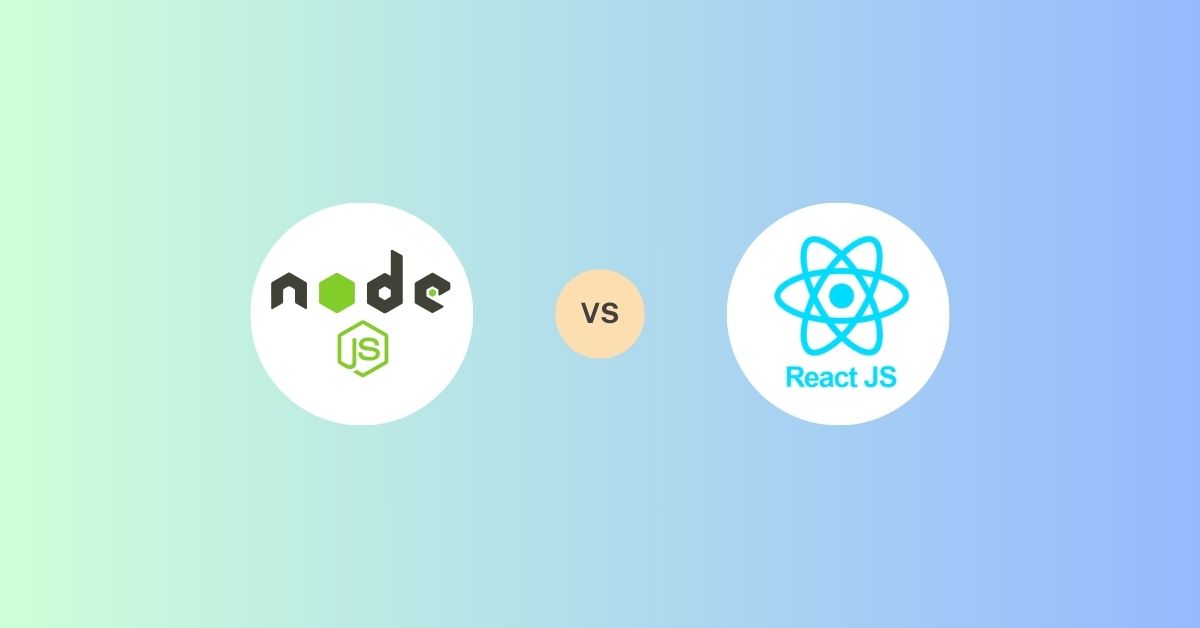Summary
In the fast-paced digital world, choosing the right technology stack is essential for the success of any web or app development project. Among the most widely used technologies today are Node.js and React.js. While they are often mentioned together, they serve different purposes and are used for different layers of development. In this blog, we will explore the difference between Node.js and React.js, their strengths, and help you decide which is the right fit for your business.
- What Are Node.js and React.js?
- Node.js vs React.js – A Side-by-Side Comparison
1. Type of Technology
2. Use Cases
3. Performance
4. Learning Curve
5. Community and Ecosystem
6. Development Speed - Node.js vs React.js – Which Is Better?
- When to Use Node.js
- When to Use React.js
- Combining Node.js and React.js for Full-Stack Development
- Real-World Applications
- Last Words
What Are Node.js and React.js?
Before diving into the comparison, let’s understand what Node.js and React.js are and how each plays a role in application development.
Developers can run JavaScript on the server side with Node.js, an open-source, cross-platform runtime environment built on Chrome’s V8 JavaScript engine. It enables scalable, high-performance backend development and is commonly used to build APIs, real-time applications like chat apps, and streaming services.
On the other hand, React.js is a front-end JavaScript library developed by Facebook. It’s used for building user interfaces, particularly for single-page applications where fast interaction and rendering are required. React.js enables developers to create reusable UI components, making the front-end development process more efficient and maintainable.
Node.js vs React.js – A Side-by-Side Comparison
To fully understand the difference between Node.js and React.js, let’s break it down into various aspects:
1. Type of Technology
- Node.js is a runtime environment for executing JavaScript on the server.
- A JavaScript library called React.js is used to create client-side user interfaces.
2. Use Cases
- Use Node.js when building backend services such as RESTful APIs, real-time applications, or microservices. It’s a great option for scalable server-side applications.
- Use React.js when your focus is on building dynamic, engaging, and responsive user interfaces on the client side.
3. Performance
- Node.js uses a non-blocking, event-driven architecture that allows for high-performance and fast execution in I/O-heavy operations.
- React.js, with its virtual DOM, ensures high-speed rendering and smooth performance on the front-end.
4. Learning Curve
- Node.js may require some understanding of server-side programming, but it’s easy for those who already know JavaScript.
- React.js has a steeper learning curve due to JSX, component-based architecture, and state management concepts, but it becomes intuitive with experience.
5. Community and Ecosystem
Both technologies boast strong communities and ecosystems. Numerous libraries, tools, and resources are available for both. Choosing the right Node.js framework, such as Express or Nest.js, can further accelerate backend development. React’s ecosystem includes tools like Redux, React Router, and Next.js.
6. Development Speed
- With Node.js, developers can use JavaScript across the full stack, reducing development time and improving coordination between front-end and back-end teams.
- React.js speeds up UI development with reusable components, making it easier to maintain and scale applications.
Node.js vs React.js – Which Is Better?
This brings us to the ever-important question: Node.js vs React.js – which is better for your business?
The answer depends entirely on your project requirements. These two technologies are not direct competitors but rather complementary tools. They are often used together in the same project, with Node.js handling the server-side and React.js managing the client-side.
If you’re building a full-stack JavaScript application, you can leverage both technologies effectively. However, if you’re focused solely on building APIs or backend services, going with a Node.js development Company can be your best bet. For front-end-heavy applications, especially SPAs and PWAs, a ReactJS Development Company can help you make the most of React’s component-based approach.
When to Use Node.js
Consider using Node.js when:
- You are developing real-time applications like chat apps or live streaming platforms.
- Your application involves a lot of I/O operations, such as reading/writing files, network requests, or databases.
- You want to use the same language (JavaScript) across both the frontend and backend.
- Scalability and performance are top priorities.
Node.js is also highly suitable for microservice architectures and works seamlessly with modern deployment platforms like Docker and Kubernetes.
When to Use React.js
You should opt for React.js when:
- You are developing a single-page application (SPA) that requires fast rendering.
- Your UI needs to be interactive, dynamic, and mobile-friendly.
- You want to build reusable components to save development time.
- SEO performance on the front-end is a priority (especially with server-side rendering using frameworks like Next.js).
React.js is ideal for customer-facing applications that require a sleek and responsive user experience.
Combining Node.js and React.js for Full-Stack Development
As mentioned earlier, the ideal scenario for many businesses is to use Node.js and React.js together. For instance, Node.js can serve as the backend RESTful API that connects to a database, while React.js can serve as the frontend that consumes that API.
This full-stack JavaScript solution enables faster development cycles, easier debugging, and better team collaboration. In certain cases, it also allows code sharing between the frontend and backend, which improves maintainability.
Real-World Applications
Here are some well-known companies using Node.js and React.js:
- Netflix uses Node.js for its lightweight, fast backend services and React.js for its dynamic user interface.
- Uber leverages Node.js for real-time features and scalable backend operations.
- Facebook and Instagram use React.js extensively in their user-facing applications.
Last Words
Choosing between Node.js and React.js is not about finding which one is superior. Instead, it’s about identifying the right tool for your business needs.
If your business requires a high-performing backend with real-time capabilities, Node.js is a powerful choice. If your priority is a fast, interactive, and engaging UI, React.js is the way to go. And if you want to build an end-to-end modern web application, consider combining both to maximize your development capabilities.
Whether you’re exploring the best Node Js framework for your backend or building an intuitive interface with React, making the right technology choice today can shape the long-term success of your application tomorrow.







